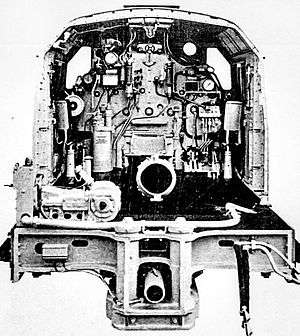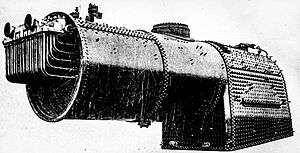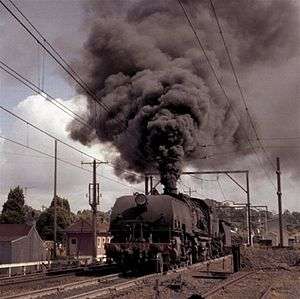New South Wales AD60 class locomotive
|
6012 at the top of Cowan Bank | |||||||||||||||||||||||||||||||||
| |||||||||||||||||||||||||||||||||
| |||||||||||||||||||||||||||||||||
| |||||||||||||||||||||||||||||||||
| |||||||||||||||||||||||||||||||||
The AD60 class were Beyer-Garratt patent articulated four-cylinder, simple, non-condensing, coal-fired superheated, 4-8-4+4-8-4 heavy goods steam locomotives built by Beyer, Peacock and Company for the New South Wales Government Railways in Australia.
Design


The 4-8-4+4-8-4 Beyer-Garratt patent consists of a boiler carried on a separate frame in the centre of the locomotive and supported by the frames of the two engines, one at each end. The locomotive thus consists of three parts: a water tank, a fixed chassis supporting a boiler and a rear engine unit carrying a coal bunker and water tank. Coupled axle loading of 16 long tons (16.3 t; 17.9 short tons) and able to negotiate 6-chain (120 m) curves.
The design incorporated the most modern technology to minimise maintenance and repairs, including:
- integral cast steel beds incorporating the engine frames
- large steel boiler with roundtop firebox and flexible stays
- mechanical stoker
- roller bearings fitted to bogie and coupled wheels
- valve gear operated by Hadfield powered reversing gear
Introduction
This was the only type of Garratt locomotive to operate on the New South Wales Government Railways. Designed to a light axle load of only 16 long tons (16.3 t; 17.9 short tons), they were intended for hauling feeder branch-line services to the main lines where heavier main-line locomotives could continue with the load.[1][2][3]
In 1949 twenty-five were initially ordered from Beyer, Peacock and Company, followed by a further twenty-five. Following a change of policy in favour of diesel traction, negotiations were entered into, in order to cancel the last part of the order. Forty-two complete locomotives were delivered, together with spare parts equating to approximately five further locomotives. The five sets of parts did not include engine unit frames. The cancellation contract stipulated that the NSWGR could not assemble the spare parts into complete locomotives without paying substantial royalties to Beyer- Peacock. The last three locomotives were cancelled completely and the assembly positions at the Gorton Works of Beyer - Peacock were sold to the South African Railways.
The locomotives were delivered in their five major component pieces: Front engine, rear engine, boiler-cab, rear bunker and front water tank. These five sub assemblies were built into a complete locomotive in NSW.
Locomotive 6002 was the first to enter service in July 1952 with the last, 6040 delivered on 02 January 1957.[1][3] The locomotives were the most powerful to operate in Australia.[4] Parts of 6002 are today incorporated into the currently operational 6029.
Improvements
Early trials established that the 14-long-ton (14.2 t; 15.7-short-ton) bunker was insufficient to allow the locomotives to operate from Enfield to Goulburn resulting in the bunkers being enlarged to carry 18 long tons (18 t; 20 short tons). Ventilation of the cabs caused considerable concern. Consequently, the class was banned from working through single-line tunnels, this ban also being in response to the difficulty crews would have climbing out in the event of failure within such tunnels. Amongst attempts to improve cab ventilation, 6011 was experimentally fitted in September 1952 with a large tube along the front bunker and boiler to funnel air from the front of the locomotive into the cab. It was unsuccessful and was removed in 1955. Some improvement was obtained by running the locomotives bunker first.[3]
Owing to the length and noise of the locomotive, crews found difficulty in hearing warning detonators. To rectify the situation, tubes were fitted to convey the sound from the leading wheels to the cab. This mechanism can still be seen today on 6040 at Trainworks.[3]
When it became apparent that the Garratts would see more service on main lines than on the lighter branch lines, it was decided to increase the tractive effort of a number of the class by enlarging the cylinder diameter and by altering the weight distribution by removing liners from the bogies. This increased the axleload on each of the driving wheels by approximately 2 long tons (2.0 t; 2.2 short tons) with 30 locomotives treated. To distinguish these improvements the double plus sign ++ was painted after the number and they were nicknamed Super Garratts. These 30 were also fitted with dual controls for bunker first running and denoted DC. To accommodate them, 105-foot (32 m) turntables were installed at Broadmeadow, Enfield and Werris Creek depots.[3]
In September 1968, the highest numbered member of the class, 6042, although only eleven years old, was nearing the end of its economic life and due to the policy of dieselisation, was scheduled for withdrawal rather than overhaul. However, with a need still for Garratts, Cardiff Locomotive Workshops assembled a Class 60 from spares it had. Cardiff Workshops also wanted to show that a steam locomotive could be overhauled just as quickly or quicker than a diesel locomotive could. In order to avoid paying the assembly royalties stipulated by Beyer - Peacock in the cancellation contract, it was decided to number the new locomotive "6042". For a very brief period there were two 6042's in existence until the original was hauled away and scrapped. However, the "new" 6042 carried the builders plates for 6043 (builder number 7545) for the next five years.[5]
Operation
The class initially entered service on the Main North and Main South and later Main Western line as far as Dubbo and Parkes. Because of their light axle load they were cleared to operate on the Crookwell, Captains Flat, Temora, Narrandera and Bourke lines.[1]
Typical workings in the mid 1960s would consist of bulk export coal and general goods movements :
| Typical Class AD60 Traffic | ||||||||
|---|---|---|---|---|---|---|---|---|
| Route | Traffic | Down (tons) | Up (tons) | Notes | ||||
| Glenlee to Rozelle | Export Coal | 1500 | ||||||
| Gosford to Broadmeadow | Export Coal | 1500 | double headed AD60's | |||||
| Gosford to Broadmeadow | General Freight | 685 single | 1100 assisted | |||||
| Broadmeadow to Muswellbrook | General Freight | 775 | 1150 | |||||
| Newstan/Awaba Colliery to Wangi PS | Export Coal | 1075 | 1500T | assisted | ||||
| Enfield to Goulburn | General Freight | 900 | 1500 | |||||
| From Botany Oil Refineries | Petroleum | 1000 | ||||||
| Goulburn to Captains Flat | Mineral | 600 | 600 | |||||
| Junee | Goods | 600 | 600 | |||||
| Cootamundra to Stockinbingal | Goods | 1000 | 1500 | |||||
| Up to Lithgow | assisting until electrification in 1957 | |||||||
| Parkes to Goobang Junction | Goods | 1000 | 1400 | 16T axle loading locos only | ||||
| Dubbo to Merrygeen | Goods | 1100 | 1000 | 16T axle loading locos only | ||||
| Parkes to Bogan Gate/Tottenham | Goods | 1000 | 1400 | 16T axle loading locos only | ||||
| Portland to Pipers Flat | Cement | 700 | ||||||
| Pipers Flat to Wallerawang | Cement | 1400 | ||||||
| Dubbo to Werris Creek | Goods | 1100 | ||||||
| Lithgow to Bathurst | Goods | 850 | 900 | |||||
| Orange to Parkes | Goods | 600 | ||||||
| Bathurst westward | Goods | 850 | 900 | dependent on grade | ||||
| W44 Broken Hill | concentrates | 575 | 600 | double headed AD60's | ||||
| Molong to Orange | Goods | 600 | 600 | double headed AD60's | ||||
Demise & preservation
To 6012 fell the melancholy honour of being the first of the class to be withdrawn, during 1955. The next few to be withdrawn suffered accident damage in major collisions in 1961 (6003 Guerie) and 1963 (6028 Glenlee). Dieselisation accounted for the other 40 (or 41) of the class from 1965. The last withdrawn was the five year old replacement "6042" which operated the final New South Wales Government Railways steam service on 22 February 1973. It then worked a ceremonial end to steam working for State Government officials on 2 March 1973.
| Preserved AD60 Class Locomotives | ||||||||
|---|---|---|---|---|---|---|---|---|
| No. | !Year | Current Organisation | Location | Status | Ref | |||
| 6029 | 1956 | Australian Railway Historical Society | Canberra | Restored/Operational | Project 6029 Blog | |||
| 6039 | 1956 | Dorrigo Steam Railway & Museum | Dorrigo | Stored | Dorrigo Webpage | |||
| 6040 | 1956 | NSW Rail Transport Museum | Thirlmere | Static Exhibit | NSW Locomotive, Steam 6040 | |||
| 6042 | 1956 | Dorrigo Steam Railway & Museum | Forbes | stored | [6] | |||
After restoration which took eight years and included the fitting of a replacement boiler sourced from a lumber mill in 1983, 6029 was first steamed at Canberra in February 2014. It has been named the City of Canberra and operated its inaugural trip from Goulburn, New South Wales to Thirlmere, New South Wales on 28 February 2015. At Thirlmere 6029 was staged alongside 6040 marking the first time in 40 years two of the same class could be seen and photographed together.
References
- 1 2 3 Oberg, Leon (1984). Locomotives of Australia 1850's - 1980's. Frenchs Forest: Reed Books. pp. 204–206. ISBN 0 730100 05 7.
- ↑ Oberg, Leon (2007), Locomotives of Australia, 1854 to 2007 (4th ed.), Rosenberg Publishing, pp. 261–263, ISBN 978-1-877058-54-7
- 1 2 3 4 5 Grunbach, Alex (1989). A Compendium of New South Wales Steam Locomotives. Sydney: Australian Railway Historical Society, NSW Division. pp. 241–247. ISBN 0 909650 27 6.
- ↑ Powerhouse Museum. "Sectioned Beyer Garratt locomotive model 6001". Powerhouse Museum, Australia. Retrieved 1 June 2014.
- ↑ "20 Years Ago" Railway Digest September 1988 page 358
- ↑ "Forbes Vintage Village Auction" Railway Digest January 1987 page 27
Further reading
- Gilbertson, CB (April 2003). "Remembering the 60 Class". Australian Railway History Bulletin. pp. 123–135.
External links
![]() Media related to New South Wales AD60 class locomotives at Wikimedia Commons
Media related to New South Wales AD60 class locomotives at Wikimedia Commons
